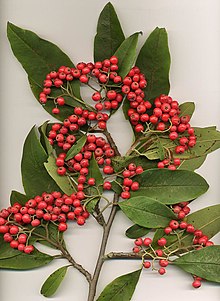| Cotoneaster | |
|---|---|

| |
| Cotoneaster frigidus foliage and fruit | |
| Scientific classification | |
| Kingdom: | Plantae |
| Clade: | Tracheophytes |
| Clade: | Angiosperms |
| Clade: | Eudicots |
| Clade: | Rosids |
| Order: | Rosales |
| Family: | Rosaceae |
| Subfamily: | Amygdaloideae |
| Tribe: | Maleae |
| Subtribe: | Malinae |
| Genus: | Cotoneaster Medik. |
| Species | |
|
See text | |
Cotoneaster /kəˈtoʊniːˈæstər/[1] is a genus of flowering plants in the rose family, Rosaceae, native to the Palaearctic region (temperate Asia, Europe, north Africa), with a strong concentration of diversity in the genus in the mountains of southwestern China and the Himalayas.[2] They are related to hawthorns (Crataegus), firethorns (Pyracantha), photinias (Photinia), and rowans (Sorbus).
Depending on the species definition used, between 70 and 300 different species of Cotoneaster are described, with many apomictic microspecies treated as species by some authors, but only as varieties by others.[2][3]
The majority of species are shrubs from 0.5–5 m (1.6–16.4 ft) tall, varying from ground-hugging prostrate plants to erect shrubs; a few, notably C. frigidus, are small trees up to 15 m (49 ft) tall and 75 cm (30 in) trunk diameter. The prostrate species are mostly alpine plants growing at high altitudes (e.g. C. integrifolius, which grows at 3,000–4,000 m (9,800–13,100 ft) in the Himalayas), while the larger species occur in scrub and woodland gaps at lower altitudes.[citation needed]
- ^ Sunset Western Garden Book, 1995:606–607 ISBN 9780376038913
- ^ a b Flora of China: Cotoneaster (includes most of the world's Cotoneaster species) www.efloras.org
- ^ Bean, W. J. (1976). Trees and Shrubs Hardy in the British Isles 8th edition. John Murray ISBN 0-7195-1790-7.